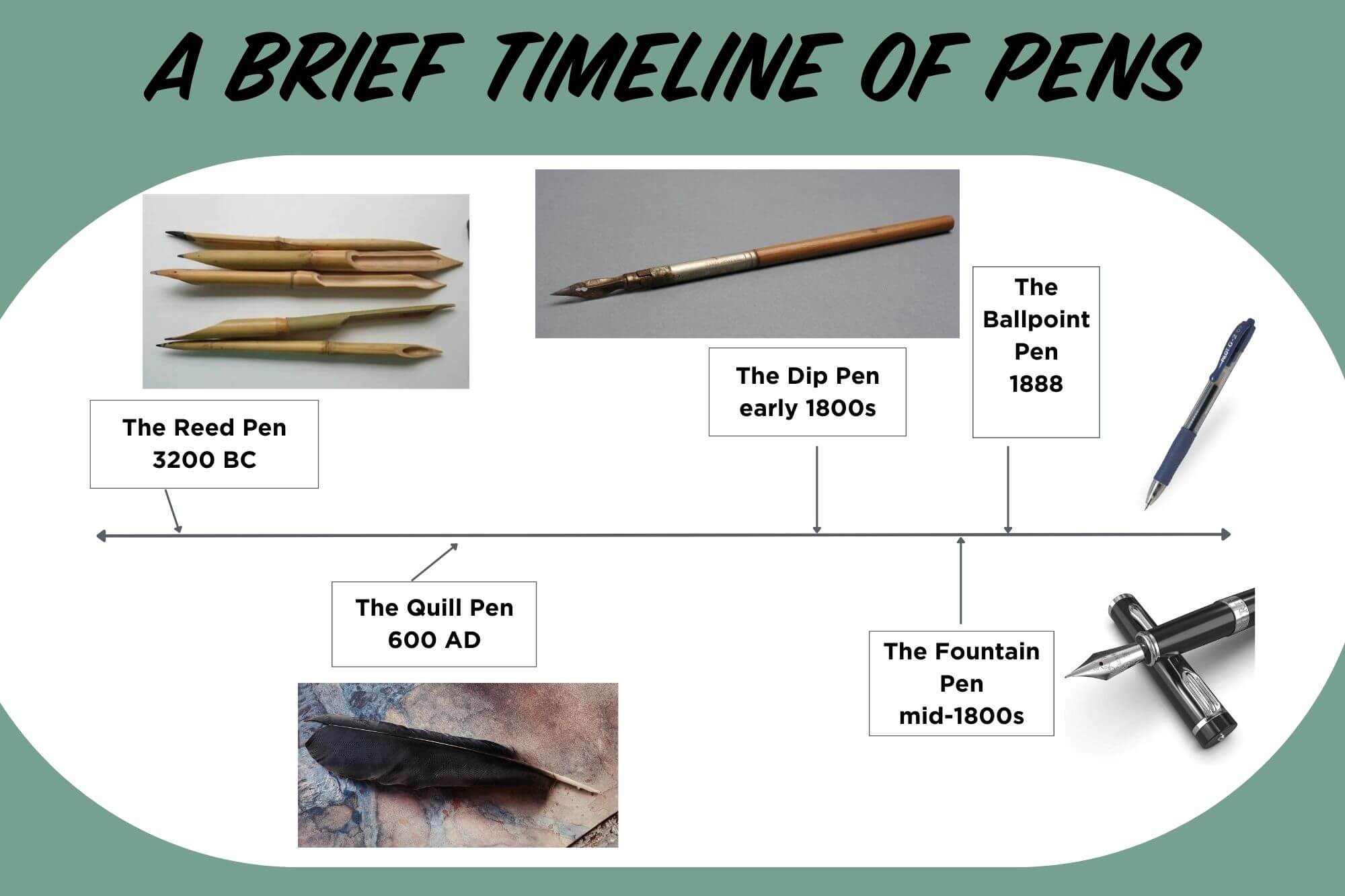Pens and the written language have been an incredibly important instrument in the way stories and messages have traveled and been preserved over centuries. Without these institutions and mediums, we would have lost so much and wouldn’t have known how those who came before us lived. History is retained through the written word. Without any instrument to encapsulate it, how would we have developed as a species?
Spreading messages and sharing stories are things that we’re incredibly passionate about. The written word can traverse oceans and cultures, bringing people together. Writing might be the closest thing we have to time travel. With enough ink and a wandering imagination, one can go anywhere they please.
***

The first pen was invented by the Ancient Egyptians in 3200 BC out of bamboo or reed, and were referred to as reed pens. They could be dipped into ink and used on papyrus, a thicker version of paper made from the pulp of a papyrus plant. In Mesopotamia, they carved into clay with these pens. This was how many cuneiform tablets were created. The thin and abundant paper we know of today was not invented yet. And, honestly, this might have been a blessing being such a fragile material; the papyrus and clay of the tablets were much sturdier and able to withstand time itself.
It wasn’t until 600 AD that the quill, which was probably what most would imagine when thinking about the “first pen”, was invented. Quills were made from real bird feathers, the more affordable options being made out of geese feathers (among other wild fowl). Swan feathers were the preference of those who could afford it, however these were quite pricey. The end of the feather was manually sharpened to create a point. Once dipped into a pot of ink, one could write whatever they pleased on parchment. The quill itself was hollow, and thanks to capillary action, ink was able to be stored like a reservoir. The writer could usually get a handful of words before needing to dip again. Quill pens were used to write many largely historical documents, think The Declaration of Independence or the Magna Carta. If the quill was properly made, it could have some longevity and could be sharpened and used over and over as long as the hollow shaft of the quill remains intact to hold ink. However, as one wrote and dipped into the pot of ink, quills grew soft and became difficult to maneuver, so many writers would have a few quills on-deck while the recently used ones dried out.
Quills were actually the norm for quite a while, there weren't any developments in the pen world until the dip pen (sometimes referred to as a nib pen) in the early 1800s. This introduced a metal tip and also became a more affordable option than a quill. They still required a pot of ink, but it made the process easier. Europe was the hub of production for these pens, specifically Birmingham, England, and mass production boomed in Germany.
Artists are primarily the only individuals that still use this kind of pen today due to the variety of possible line thicknesses. Quills are also still used today to write many different Jewish holy texts.
The fountain pen, which many people still use today, was patented around the mid-1800s. This introduced an inner vestibule that held the ink inside of the pen allowing for a steady flow of ink when pressed upon the paper, instead of needing to require a pot of ink for dipping. There were versions of this pen prior, some even think Leonardo da Vinci invented and used an iteration. However, many of these original attempts didn’t consistently work and had many construction issues. These more heavily researched patents helped simplify the process even further, making the pen a single, easily transportable product.
The ballpoint pen that we know and have in our possession was introduced in 1888. The rolling ball at the tip of the pen helped prevent the ink from drying out and also distributed the ink evenly on the page. This key component allowed the pen to be more durable and increase its longevity. Original versions were refillable, but now most ballpoint pens were disposable and a common promotional tool.
The world of pens has grown to include gel pens, felt tip pens, erasable pens, and even pens that can be used in zero gravity and can write upside down. The medium has moved away from necessary utility and now it lives as a means of personalization. We all know that girl who had the big box of gel pens with every single color, the talk of every elementary school classroom. What we choose to write with matters and says something about us because there are so many choices.
Maybe the pen of now is a stylus for tablets, easily able to capture one’s specific handwriting and expresses some character. Funny enough, many people also use their fingers (whether it be typing on a keyboard or drawing on a touchscreen or taking down an observation in one’s notes app), in a way harkening back to our origins or carving away at clay with our own bare hands, creating something out of stone to last for centuries, just like the very digital things we create now.
Nonetheless, pens haven’t disappeared from our world and there’s no sign of them leaving any time soon. There hasn’t been anything that has come along and has knocked off the ballpoint pen from its pedestal, and maybe that’s okay because it seems like a pretty perfect product. Nothing can replicate the feeling of putting a pen to paper. Whether it be a to-do list, taking notes in class, or everyday journaling, there is something magical that comes with the inherent creation of wielding a pen. A necessary tool found in every backpack, glove box, and desk. It feels impossible imagining a world without them readily in our hands.
We have also done the service to help you break in your new pen with this special assortment of songs that are especially inspiring to write to! Make sure to follow Busy Beaver on Spotify so you never miss any of our playlists.

